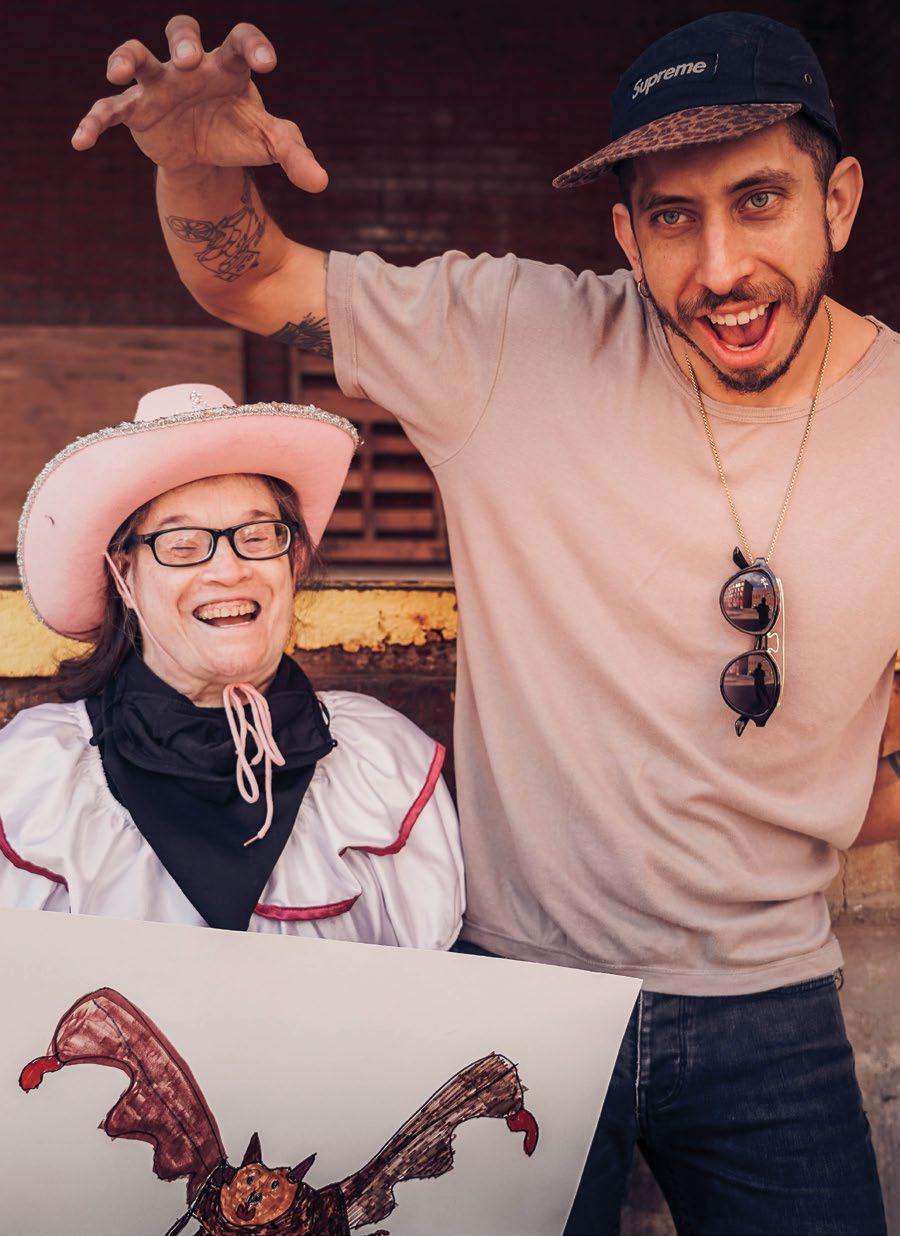
5 minute read
Supporting Artists with Disabilities
Photo of studio artist Jean Wilson with Vincent Uribe courtesy Arts of Life
Supporting Artists with Disabilities
By Vincent Uribe
What does it mean to be an artist with a disability? Should we look at artwork or value it differently when someone with a disability creates it? These questions are complicated by the fact that we live in a society that doesn’t fully appreciate, embrace or foster any artist to their full extent. I firmly believe that we should support all artists, including those with disabilities, and that making that possible is more nuanced than many may realize.
As an artist whose practice centers on social curation, I have worked with hundreds of artists over the past 12 years through a multitude of social events, from gallery exhibitions to creative workshops to late-night dance parties to benefit art auctions. I have dedicated my career to supporting emerging to mid-career artists’ professional development. The core of my practice is uplifting artists from a variety of backgrounds in order to promote integration, create dialogue and build a respectful, open community.
In many ways, supporting artists with disabilities is no different than supporting artists without disabilities. It takes time and a foundation of mutual respect to nurture a relationship with any artist. One likely wouldn’t ask a stranger a personal medical question without getting to know them first. When working with, admiring or collecting from artists, personal histories are just that—personal. Artists with disabilities deserve the same respect of privacy as anyone else, and whatever medical diagnosis they may have (mental, physical, developmental, emotional) should be left to the individual—without expectation—to disclose anything. Suppose an artist’s disability is not intrinsically part of their work, the same way an artist’s background or sexual orientation might not be. In that case, that information is presumed private and irrelevant to the value of the practice. Asking about an individual’s diagnosis is rude and insensitive and should not influence one’s perspective on the work.

Photo of Vincent Uribe courtesy Arts of Life and Vincent Uribe
Beyond relationship building, it also takes time and care to successfully incorporate many voices into the process. At Arts of Life, a creative collective for artists with intellectual and developmental disabilities, we are guided by a model of Collective Decision Making. Our artists have a voice in decisions both large and small—from strategic planning and staff hiring to party planning.
However, as our community has grown, it became increasingly untenable to offer every opportunity to every artist. So, we developed the Artist Enterprise Program to support our artists in their chosen professional development track. In my role, I work directly with the Curatorial Committee to plan our gallery exhibitions. In order to promote integration and increased exposure, I invite a guest curator— usually an emerging artist who has never curated before—to partner with our committee on an exhibition. The guest curator works with the committee to identify the theme, make final selections of artwork, and install the work. Bringing our artists into the process definitely elongates the timeline, but ultimately each exhibition is richer for it. And by creating a space to nurture these collaborations, guest curators and artists then carry those experiences into future projects. So, our artists now are featured in exhibitions across the country beyond those we at Arts of Life directly coordinate.

Photo of an Arts of Life exhibition opening courtesy Arts of Life

Photo of studio artist Christianne Msall courtesy Arts of Life
At the same time, there are external forces that make supporting artists with disabilities different. The starving artist is real, and most artist funding is limited. For artists with disabilities, the challenges of receiving support are exacerbated by outdated and backward rules. In the U.S., people with disabilities must live in poverty to maintain their state disability benefits. If their income or savings exceed $2,000 a month, they risk no longer qualifying for necessary medical support. For an artist with intellectual or developmental disabilities, this could also threaten their housing. This keeps them tied to an unfortunate government system of suppression. As the visibility of our artists grows, so do their art sales. Our team plans creatively with our artists to ensure the payouts do not have an unintended cost.

Photo of Vincent Uribe courtesy Arts of Life and Vincent Uribe
Ultimately, what I have learned is that a one-size-fits all approach does not work in this sector. Regardless of our current disability status, we each bring our own life experiences and skills to the table. By getting to know artists as individuals, we can foster the trust and understanding needed to support them effectively and help the art world to thrive.
Vincent Uribe (@vcentu) is a creative community builder. As Founding Director of LVL3, he has organized hundreds of exhibitions featuring emerging and midcareer artists. At Arts of Life, he has launched the Circle Contemporary galleries and facilitated public exhibitions for artists with intellectual and developmental disabilities at the Chicago Cultural Center, Art on the MART and the Ukrainian Institute of Modern Art. Vincent serves as a founding board member for Equity Arts.





